More Than a Resource: Time as the Medium of Development
Even excellent time management misses something fundamental. When we treat time only as a resource to optimize, we overlook how development actually unfolds. The shift from managing time to understanding it as the medium through which development occurs can transform how we approach work and life.

You might be excellent at time management. You use sophisticated systems, maintain clear priorities, and achieve impressive productivity. You've read the books, implemented the methods, and optimized your schedule. Yet something still feels off: a subtle friction between your well-managed schedule and the rhythms of meaningful progress. Breakthroughs seem to happen despite your planning rather than because of it. Your best insights emerge in the margins of your calendar. Deep work feels forced into boxes that never quite fit its actual flow.
The issue isn't poor time management. It's that thinking of time as a resource, even when that resource is expertly managed, misses something fundamental about how growth and development often unfold.
The Limitation of Resource Thinking
When we treat time as a resource, we focus on allocation, efficiency, and optimization. This works well for many purposes. Resource thinking helps us meet deadlines, juggle responsibilities, and accomplish immediate goals. Many successful people and organizations excel at this approach.
But resource thinking contains a hidden assumption: that time is a neutral container we fill with activities. This view makes time external to development itself, something we use for development rather than the medium through which development occurs.
This matters because different types of work and growth follow different patterns. Some tasks truly are resource problems: routine processes, defined procedures, and emergency responses often benefit from pure efficiency optimization. But much of our most important work, especially anything involving learning, creativity, or relationship building, follows patterns that resource thinking alone cannot capture.
Consider how this plays out. A well-organized executive might efficiently allocate time across strategic planning, team development, and operational tasks. They batch similar activities, protect focus time, and maintain work-life boundaries. By every measure of time management, they excel. Yet they might still find that genuine breakthroughs feel accidental, that team cohesion develops unpredictably, or that their most valuable insights emerge outside their carefully managed schedule.
This isn't a failure of their system. It's a sign that something important operates beyond resource optimization, particularly for complex, developmental work.
Time as the Medium of Development
Here's the shift: instead of thinking of time as something we have and use, we can understand it as the dimension through which all development necessarily unfolds. This isn't wordplay but a fundamental reorientation that changes how we engage with time.
Think about how a river shapes a landscape. The river doesn't just flow through the land; over time, it creates valleys, deposits sediment, and fundamentally alters terrain. The landscape's development can't be separated from the temporal process of water flowing. Similarly, our development, whether personal, professional, or organizational, doesn't just happen "in" time. It exists as temporal patterns.
A relationship doesn't use time to develop; its development is a temporal pattern of interactions, responses, and shared experiences. A skill doesn't consume time to improve; improvement is the temporal pattern of practice, feedback, and integration. An organization doesn't spend time to evolve; its evolution is the temporal pattern of learning, adapting, and restructuring.
This shift from resource to medium can change everything about how we approach time.
What Changes When You See Time as Medium
When you understand time as the medium of development rather than a resource for it, natural coherence emerges where there was once tension.
Take how we typically experience conflict between "getting things done" and "developing capabilities." Resource thinking frames this as competition for limited time. But when you see time as medium, you recognize that immediate actions and long-term development aren't separate activities competing for resources. They're different aspects of the same temporal flow. A conversation with a team member simultaneously addresses today's coordination need while building the relationship that enables future collaboration. The temporal pattern serves both without dividing.
Or consider the guilt many feel about "unproductive" time. Resource thinking labels periods of reflection, transition, or restoration as time not well spent. But understanding time as medium reveals these periods as essential parts of developmental patterns. The walk between meetings isn't lost time; it's when integration happens. The quiet morning before diving into tasks isn't delay; it's when orientation emerges.
This reframing particularly transforms how we approach complex challenges. Resource thinking pushes us to allocate sufficient time to problems. Medium thinking helps us recognize that solutions emerge through specific temporal patterns: periods of intense engagement alternating with apparent dormancy, sudden insights following patient groundwork. You stop trying to force breakthrough on a schedule and start creating conditions where natural developmental patterns can unfold.
Recognizing Patterns Versus Imposing Structure
The value of seeing time as medium is how it helps us recognize recurring patterns that resource thinking often obscures. Different types of development tend to follow characteristic temporal signatures in specific contexts.
Creative work often follows patterns of divergent exploration, incubation, and convergent refinement. You can't simply allocate three hours to creativity and expect linear output. But when you recognize and work with creativity's common patterns, you might structure time to support each phase.
Learning frequently follows patterns of exposure, practice, integration, and application. Resource thinking might efficiently schedule training sessions, but medium thinking recognizes that learning happens in the spaces between formal sessions as much as during them. This awareness can lead to temporal structures that support the full learning cycle.
Relationships tend to develop through rhythms of connection and autonomy, intensity and routine, challenge and support. No amount of scheduled "relationship time" can substitute for engaging with these rhythms. But when you recognize relationships as temporal patterns, you might create conditions that better support their development.
These patterns aren't universal laws but common tendencies that vary across contexts, cultures, and individuals. The shift from forcing time into predetermined structures to recognizing and working with whatever patterns emerge in your specific situation doesn't mean abandoning discipline or planning. It means your discipline and planning can emerge from understanding how development tends to occur in your context rather than from abstract efficiency principles.
Practical Implications Without Prescriptions
This perspective shift generates practical insights without requiring rigid implementation:
When planning projects, you might build in phases that match how development tends to occur in your field rather than arbitrary milestones. You recognize that certain stages often can't be compressed without compromising quality, while others might move faster than traditional planning suggests.
When structuring your days, you might notice which patterns tend to support your best work and protect these without needing elaborate systems. If complex thinking often requires morning focus, this becomes a consideration rather than a rule to follow.
When building teams, you might create rhythms that support both task completion and relationship development. Regular patterns might emerge not from management theory but from recognizing how human systems tend to develop coherence over time in your specific organizational culture.
When facing constraints, you might make different trade-offs. Instead of asking "How can I fit everything in?" you ask "Which patterns are essential for what we're trying to develop?" This often leads to doing less but with greater developmental impact.
Working Within Business Realities
This approach doesn't require perfect conditions or unlimited flexibility. In fact, it often works better within constraints because it helps you see which patterns matter most.
In high-pressure environments, understanding time as medium helps you distinguish between truly urgent demands and those that merely feel urgent. You recognize which developmental patterns can flex and which, if broken, undermine everything else. This clarity improves decision-making under pressure.
When schedules feel impossible, medium thinking helps you find coherence where resource thinking sees only conflict. That difficult client meeting isn't stealing time from strategic planning. It's part of the temporal pattern through which strategy emerges through engagement with real constraints.
When working within organizational systems, this perspective helps you navigate more skillfully. You recognize which organizational temporal patterns support development and which obstruct it. This awareness helps you work more effectively within existing structures while gradually influencing them toward greater coherence.
But What About Deadlines?
A natural question arises: how does this philosophical shift help when you have real deadlines to meet? The answer is that understanding time as medium often makes you more effective at meeting deadlines, not less.
When you recognize the patterns of how work develops in your context, you can better estimate how long things actually take. Instead of optimistic scheduling based on ideal efficiency, you account for fuller patterns: the ramp-up time complex work typically requires, the integration periods between intensive efforts, the iterations that quality usually demands. This leads to more realistic commitments and fewer last-minute scrambles.
Understanding time as medium also helps you work backwards from deadlines more effectively. If you know a project needs certain developmental phases that can't be compressed without compromising quality, you can identify the latest possible start date that respects these patterns. You might discover that starting earlier with a sustainable rhythm produces better results than a compressed sprint that burns out your team.
Most importantly, this perspective helps you distinguish between artificial urgency and genuine time constraints. When you understand how development typically unfolds in your domain, you can push back on unrealistic deadlines with concrete reasoning: "This type of analysis typically requires a minimum of three iterations with reflection time between each. If we compress that, we risk missing critical insights that will cost us more time later." This isn't making excuses; it's explaining the temporal reality of quality work in your specific context.
The key insight is that by respecting common development patterns, teams often move faster overall. Groups that maintain sustainable rhythms tend to have fewer errors to fix, less rework from rushed decisions, and better morale that translates to higher productivity. The deadline still matters, but you meet it by working with time rather than against it.
The Paradox of Letting Go and Gaining Control
Perhaps the deepest insight from seeing time as medium is how letting go of certain controls can enhance actual influence. When you stop trying to manage time purely as a resource and start working with it as medium, you might find:
- Solutions emerge more readily because you're aligned with how development tends to happen in your field rather than forcing predetermined timelines.
- Energy increases because you're working with common patterns rather than against them.
- Coherence develops as different aspects of work and life find their temporal relationships.
- Sustainability improves because you're not constantly fighting against how things tend to unfold.
This isn't magical thinking but practical recognition of how complex systems develop. Just as a gardener works with seasons rather than commanding plants to grow on schedule, working with time as medium means creating conditions for development rather than trying to control it directly.
A Different Relationship with Time
The shift from resource to medium thinking doesn't invalidate good time management practices. Calendars, priorities, and systems remain useful tools. What changes is the fundamental relationship. Resource thinking and medium thinking can coexist, each serving different aspects of our work and life.
- Instead of asking "How can I manage my time better?" you might ask "What rhythm does this work typically follow?"
- Instead of optimizing for maximum efficiency, you might optimize for maximum coherence.
- Instead of feeling guilty about "wasted" time, you might recognize apparently empty periods as essential parts of larger patterns.
- Instead of forcing activities into arbitrary timeframes, you might discover the rhythms that tend to support sustainable high performance in your context.
This shift is available to anyone, regardless of their current time management approach. It doesn't require overhauling your system or fighting organizational culture. It begins with simply recognizing that development, whether your own, your team's, or your organization's, isn't something that happens in time but as time.
From this recognition, new possibilities emerge. Not through another system to master but through alignment with how development tends to occur in your specific context. The result isn't just better productivity but enhanced viability: the sustained capacity to thrive within real constraints while continuing to develop. And that, perhaps, is what we're really seeking when we try to manage time in the first place.





